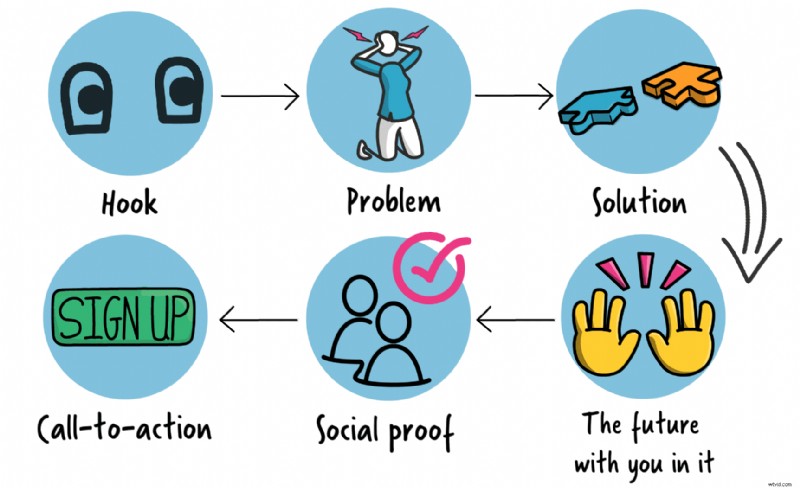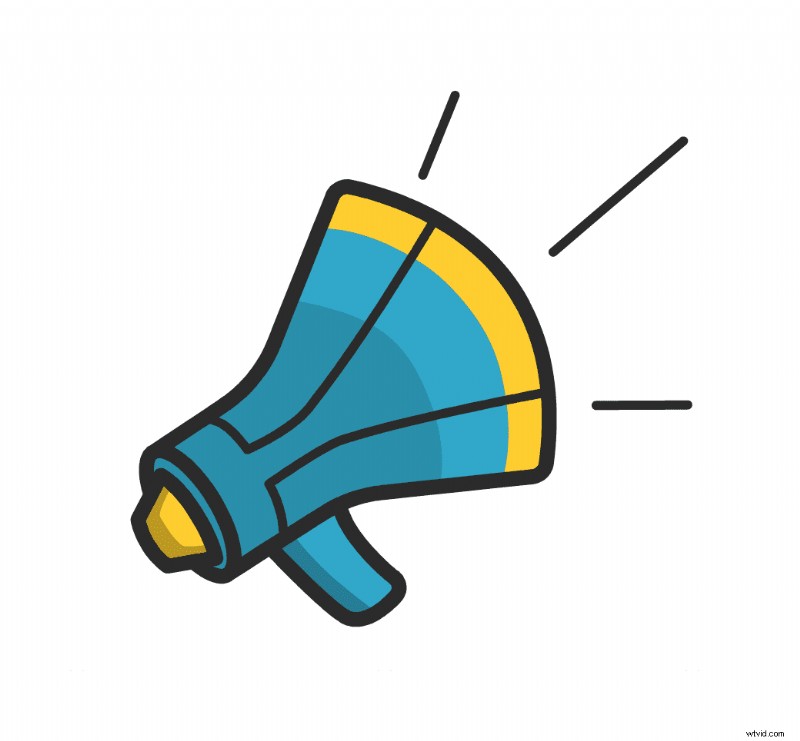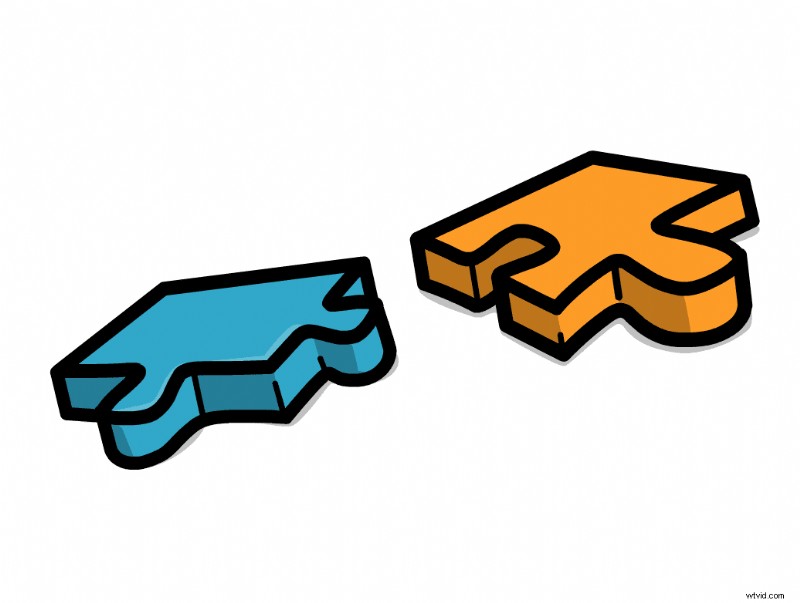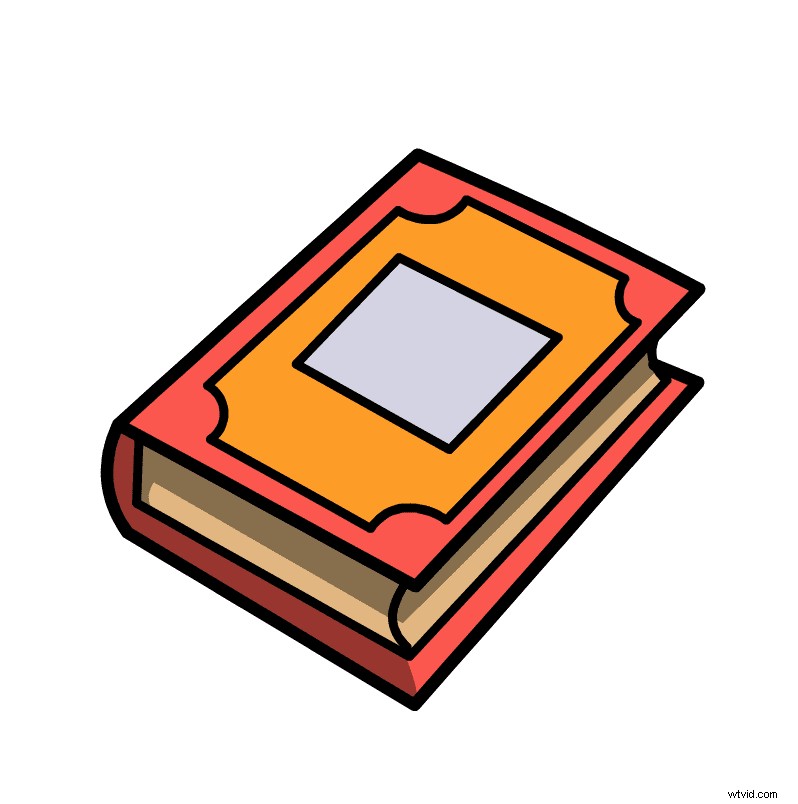Entonces, desea escribir un guión que no solo enganche a su audiencia, sino que los deje con ganas de aprender más. Tenemos que advertirte, no siempre es fácil. ¡Pero las mejores cosas nunca lo son!
Escribir un guión convincente para un video explicativo irresistible requiere tiempo y práctica. Pero afortunadamente para usted, hemos escrito muchos de estos antes, por lo que estamos aquí para ayudarlo a acelerar el proceso compartiendo nuestros consejos y trucos probados y probados para escribir guiones que se noten.
Ahora, antes de entrar en los pasos para escribir su guión, retrocedamos rápidamente para comprender exactamente qué queremos decir con un video explicativo y por qué escribir su guión es una parte tan importante de crear uno. Si quieres saltarte, usa nuestros enlaces a continuación 👇
1. ¿Qué es un video explicativo?2. ¿Por qué es tan importante el guión de su video explicativo?
3. Nuestro proceso probado para escribir guiones de videos explicativos
- Define tu POR QUÉ con un resumen creativo
- Identifica tu historia
- Escribe tus 'imprescindibles'
- Crea tu gancho para llamar la atención desde el principio
- Empatizar:demuestre que comprende el problema de su cliente
- Presentar la solución - su producto, servicio o idea
- Pinta una imagen de cómo se ve el futuro contigo en él
- Refuerza tu mensaje con prueba social
- Dile a tu espectador qué hacer a continuación.
- Editar, ajustar y comprobar
¿Qué es un video explicativo?
Un video explicativo es un video corto que cuenta la historia de su negocio, productos y servicios, o una idea de una manera atractiva y concisa.
Si bien las empresas suelen utilizarlos para respaldar las ventas y el marketing, también pueden ser utilizados por educadores y profesionales para transmitir nuevas ideas y aumentar la comprensión de nuevos temas.
Los videos terminados se pueden compartir en casi cualquier lugar, desde sitios web y blogs hasta correos electrónicos, redes sociales y presentaciones. ¡La belleza de un video explicativo es que es súper flexible y se puede adaptar para adaptarse a casi cualquier tema! Aquí hay un ejemplo 👇
Por qué es tan importante el guión de su video explicativo
Los videos explicativos son tan efectivos porque apelan a múltiples sentidos. Con imágenes en forma de animación o gráficos y audio de una voz en off y/o música de fondo trabajando juntos, podemos procesar la información mucho más rápido y más fácil.
Además, los videos explicativos pueden provocar una respuesta emocional al aprovechar nuestros mayores temores, problemas o esperanzas y, por lo tanto, hacer que los videos sean súper memorables.
Pero para lograr este efecto, tienes que crear un comienzo con bases sólidas. Eso significa tomarse el tiempo para establecer para quién es su video, qué quiere que sientan, qué quiere lograr y qué quiere que hagan después. Esta información luego informa su guión, que actúa como la columna vertebral de su video. En pocas palabras, si aciertas con tu guión, es probable que el resto de tu video sea un éxito.

Nuestro proceso probado para escribir guiones de videos explicativos
Ahora - sobre las cosas buenas. Cómo puede escribir un excelente video explicativo siguiendo nuestro sencillo proceso de 10 pasos. Comencemos...
1. Define tu POR QUÉ con un resumen creativo
Bien, entonces sabes que quieres crear un video explicativo, pero ¿has explicado realmente por qué? Esto puede sonar como una pregunta obvia, pero desea ir más allá de las respuestas vagas como "aumentar la conciencia". Cuanto más detallado y enfocado sea su objetivo, más efectivo será su video.
He aquí un ejemplo:
"Nuestro nuevo producto supera a todos nuestros competidores con su tecnología pionera. Pero necesito un video explicativo para ayudar a nuestros clientes a comprender cómo es diferente y por qué es tan beneficioso para ellos para que actualicen su cuenta con nosotros".
Recomendamos trabajar con estas preguntas para comenzar a construir su resumen:
- ¿Por qué quieres crear un video explicativo? Probablemente no estés creando este video solo por diversión, por lo que estar seguro de tu objetivo final puede ayudarte a mantener el rumbo y escribir un guión efectivo.
- ¿Qué mensaje quieres transmitir? Es fácil desviarse y compartir información que le interesa y que puede no ser siempre relevante para su audiencia. Así que concéntrese realmente en uno o dos mensajes clave que su audiencia NECESITA saber.
- ¿Por qué le importará a la gente? Nuevamente, cuando su negocio, idea o tema está tan cerca de usted, a veces es difícil verlo desde una perspectiva externa. Si su audiencia aún no sabe que necesita su producto o servicio, piense en cómo puede hacerlo relevante para ellos. La técnica de cuestionamiento de los '5 por qué' (plantilla GRATUITA aquí) puede ayudarlo a identificar los principales puntos débiles o deseos de su audiencia. Compruébalo 👇
- ¿Qué valor proporcionará esta información? Para que un video explicativo tenga éxito, debe aprovechar lo que le importa a su audiencia. Así que considéralo desde su perspectiva, ¿cómo se beneficiarán al ver tu video?
- ¿Qué quiero que se lleve mi espectador? Si bien recordamos mucha más información del video que el texto o el audio solos, aún no puede esperar que su audiencia recuerde cada elemento de su video explicativo. Entonces, si solo pudieran recordar una cosa, ¿qué te gustaría que fuera? Saber esto realmente te ayudará a concentrarte en tu mensaje central.
2. Identifica tu historia
Ahora que sabe lo que quiere lograr y el mensaje que necesita transmitir, puede entretejerlo en una historia convincente. Esto puede sonar complicado, pero no tiene por qué serlo. La mayoría de los videos explicativos siguen una de dos estructuras de historias muy efectivas. Estos son...
Estructura del problema a la solución
Esta es la estructura clásica para muchas explicaciones de negocios, productos, servicios o ideas. En el centro de todo, usted es el héroe que facilita la vida de sus espectadores con sus clientes establecidos como personajes en el cuento. La historia comienza haciendo que el problema sea claro y comprensible y luego se arquea en una transición natural hacia la solución.
A lo largo del proceso, puede agregar toques extra memorables mediante la creación de múltiples voces para representar diferentes personajes o agregar giros argumentales adicionales para mantener las cosas interesantes. Esta es la estructura en la que nos vamos a centrar para este blog.

Estructura general del proceso
Alternativamente, si está explicando un servicio o un producto, es posible que la estructura de descripción general funcione mejor. A diferencia del 'Problema a la solución', se enfoca principalmente en un viaje lineal que un personaje (probablemente su cliente o usuario) toma para completar la tarea. Si elige esta estructura, puede omitir los detalles sobre el problema de su cliente e ir directamente a lo jugoso:¡la solución!

3. Anota tus 'imprescindibles'
En este punto, es hora de empezar a escribir. Pero sentarse a escribir un guión perfecto de una sola vez rara vez sucede y puede ser muy intimidante. Por lo tanto, recomendamos obtener algunos puntos aproximados para comenzar a trabajar.
Esto podría ser de 5 a 10 viñetas de información que absolutamente debe incluir en su video como parte de su historia. Utilice el trabajo que ha realizado en los dos pasos anteriores para ayudarlo a identificar estos mensajes centrándose en lo que su audiencia necesita saber, por qué debería importarles y con qué quiere que se vayan.
En 10-15 minutos tendrá un bosquejo aproximado de sus puntos esenciales y dónde encajan en la estructura de su historia. Desde aquí es mucho más fácil completar los espacios en blanco sin la preocupación de perder información clave.

4. Crea tu gancho para llamar la atención desde el principio
¡Desde su contorno aproximado, ahora puede comenzar a suavizar los bordes, agregar personalidad y traer el dinamismo! Comenzando con su introducción, como sabemos, si no puede llamar la atención en los primeros segundos de su video, su audiencia se apagará antes de escuchar el resto. Por lo tanto, acertar con el comienzo de su guión es muy importante... ¡sin presión!
Pero hay muchas maneras de hacer esto. Echa un vistazo a las 6 opciones que amamos 👇
La técnica de amplificación 
Esta es una de las técnicas más populares y por una buena razón, es altamente efectiva. Se trata de tomar algo que parece menor y demostrar que en realidad es un problema grave. O al revés:tomar un problema que parece aterrador o complicado y simplificarlo. Este factor sorpresa hará que la gente esté atenta a cada una de tus palabras.
Ejemplo:sabemos que la malaria mata a medio millón de personas cada año y tenemos una cura desde el siglo XVII. ¿Esperar lo? Ahora tienes toda nuestra atención.
La técnica sensorial
Otra forma de atraer a su audiencia es despertar su imaginación al establecer una escena con detalles vívidos o pedirles que recuerden un recuerdo en particular. Aprovecha las vistas, los sonidos, las sensaciones y los olores que podrían experimentar para sumergirlos en tu historia. Nuevamente, como esto nos hace pensar en un nivel multisensorial, recordamos más información, por lo que es beneficioso para todos.
Ejemplo:Nos encanta esta charla TED de Amy Cuddy, quien comienza pidiéndole a su audiencia que haga una auditoría de sus cuerpos. Ella les preguntó '¿cuántos de ustedes se están haciendo más pequeños? ¿Quizás estás encorvado, cruzando las piernas o envolviéndote los tobillos?'. Esto llama inmediatamente la atención y activa la conciencia sensorial de la audiencia.
La técnica del rompecabezas

Pocos de nosotros podemos resistir un desafío, así que llame la atención con un rompecabezas the piques curiosity. From problems and riddles to math problems and tongue twisters, there are lots of different ways you could use this and tie it back to your message.
You could leave the puzzle open-ended as something to ponder, direct your audience to somewhere they can find the answer, or even promise to tell them the answer at the end to hold attention for longer!
Example:Dan Pink's opener "If someone gave you a candle, some thumbtacks and some matches, could you attach the candle to the wall so the wax doesn't drip onto the table?" 👀
The question or rhetorical question

Whether you expect an answer or not, asking a question is a great way to start your explainer video. It gets your audience thinking about everything from their personal experiences, memories, identity or general knowledge - whatever works for your subject. You can also use questions to gently nudge your audience towards your desired conclusion or help them recognize problems that you can solve.
Example:from where you're sat watching this, nod your head if you've experienced stress in the last year... in the last month... in the last week... in the last 24 hours.... This would start to show just how much stress could be impacting their life.
Humor
Now this one can be super tricky but when done right, it's the ultimate crowd pleaser. Humor makes your audience feel at ease, more receptive to your idea and warmer towards you. The best (and safest) jokes use self-deprecating humor to make light of yourself or a situation you've been in. This opener works really well as a story and so links to our next option.
Example: Shawn Anchor's perfect comic timing makes this opening story super funny. We can't resist liking him and being drawn in as the tale unfolds.
Once upon a time 
Last but by no means least, you could start your explainer video and grab attention with a story. Similarly to Shawn's example above you can combine a story with any of these previous techniques.
Stories are one of the most effective tools to inspire empathy and understanding in your audience. They give us something to relate to and we can imagine ourselves in the situation. Storytelling also builds more personal connections faster as you have to show your vulnerability to tell them.
Example: "I'll never forget that day back in the spring of 2006..." Even a simple opener like this intrigues us and gets us wondering what could be so bad, good or incredible that would stay with you for so long.
5. Empathize - show you understand your customer's problem
Once you've got all eyes on your video, it's time to build more emotional connections as we know this is the best way to ensure your video gets remembered. One way to do this is by showing empathy. By this we mean really showing you understand your audience and the pain points or problems they're experiencing.
That could mean you reference thoughts and feelings they might have had or go into extra detail about the impact the problem has on other areas of their life. Not only will this make them feel heard and seen but it's a great way to position yourself as a trusted partner, not just a faceless business or salesperson.
6. Introduce the solution - your product or service
Once your audience can see themselves in your video the story flips. Now's the time to show your audience how you can make those problems go away or help them achieve their much longed for ambitions.
Just be sure to keep this section short and succinct, focusing only on those key bits of information your audience absolutely needs to know about your product, service or idea. You can refer back to your 'must-haves' list to help with this.
If in doubt - just think would a child understand this? It's always a good test to help eliminate jargon and really distill your message down into its simplest form.

7. Paint a picture of what the future looks like with you in it
However, it's not enough to just explain how you can help, it's key to complete the story by giving your audience a glimpse at what life with you could be like.
It could be that you help them do something boring faster so they can spend more time with their children. Or you remove a blocker to help sales people sell more and reach their bonuses - hello extra vacation!
Painting a vivid picture of this vision can not only help it seem more attainable but also make your audience want it more. After all, who doesn't want to imagine themselves on a tropical vacation (especially now 😍) or with more spare time on their hands!?
8. Reinforce your message with social proof
Now we're nearly ready to wrap up the video. But before you do, a sprinkling of social proof can ease any final concerns your audience might have.
Social proof includes content like positive reviews, customer quotes or information about your existing customer base. It's what we all look for when booking a hotel or buying something online - that validation that the company is going to do what they say they will.
With that in mind, it's a great addition to the end of your explainer video. Simply include a quote or customer star rating to reinforce your message.
9. Tell your viewer what to do next
Hooray - we're onto the final step in writing your script! All that's left to do is end strong by telling your audience what to do next.
If your goal was to encourage prospective customers to buy your product or service then tell them how they can do so. If you wanted to pique you audience's interest in your topic then tell them where they can find out more.
Don't leave it up to chance that your viewers will know where to turn next! Be sure by ending your video with clear and direct instructions on what to do next if they liked what they saw/heard.

10. Edit, adjust and check
With that you just finished the first draft of your script - congratulations! Take a moment to feel that accomplishment before we get into editing mode.
This is where your draft script turns into polished perfection ready for your voice-over to be recorded. There are a few things to look out for and check as you reread your script. But before we do we recommend you take at least 10 minutes away from it (ideally 24 hours) to help you see the script with fresh eyes. We also know how hard editing is when you love the say a certain sentence or phrase sounds, or perhaps you really want to include extra information that there isn't space for. This is the time to take a step back and detach yourself from the writing - this is the time to be objective.
So, here we go - these are the final elements we check before signing off on a script:
- Does it pass the first grader test? As we mentioned earlier on in this guide, the best explainer videos are super simple and easy to understand, even by a child. So review your content and check it for any technical jargon, complex sentences and detail that's just not needed.
- Length - is it too long, too short or just right? Most explainer videos range from 1 - 3 minutes in length depending on the topic and content. We wouldn't recommend explainer videos of more than 3 minutes for marketing and sales purposes specifically as your audience is likely to tune out. You can use free tools to help you determine the current length of your script and make adjustments as needed.
- Tone of voice - whether you're speaking as your brand, an individual or a narrator, the tone of your writing not only has to be consistent but make sense for the video. Also bear in mind that as your script will be spoken and not read, it should sound a little less formal and more like you're talking to a friend.
- Read it aloud - as we mention in the point above, your script should sound natural when spoken, not like you're reading from the dictionary. So practice reading it yourself and check for any sentences that are too long, stuffy or complex.
Once your script passes these final tests it's ready to share with the world! Get your voice warmed up and ready to record your stand-out voice-over. Happy recording!
With that, you're ready to animate! Put your knowledge into practice by creating your own animated video. Start a free 7-day trial (no credit card needed) or join our creative community by becoming a VideoScribe subscriber! 👇

